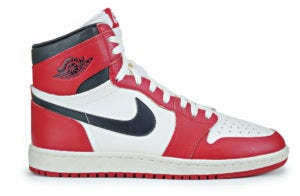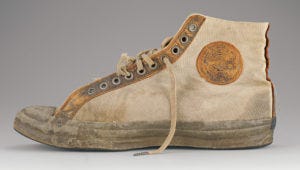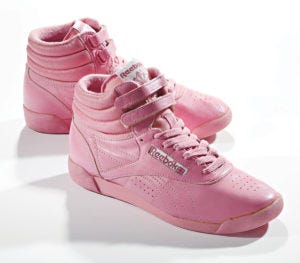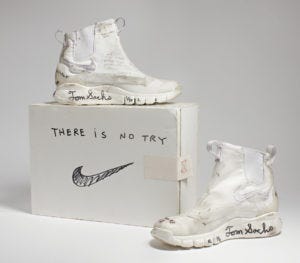Oakland Museum of California presents sneakers as art objects with rich history
By Jodi Monahan

PICTURES COURTESY OF OAKLAND MUSEUM OF CALIFORNIA
Since the late 1800s, when London police officers began quietly sneaking up on criminals with a newly- designed rubber soled shoes, the sneaker has become part of the fabric of athletic, cultural and even political life.
Sneakers, which were first called plimsolls, can reveal everything from race and class to political affiliation.
Recently, they ran head on into political controversy.
In November, New Balance’s public support of President Trump’s protectionist policies led a Neo-Nazi blog to declare the brand “the official shoe of white people.”
Some upset New Balance customers threw away their shoes and even set them on fire to protest the declaration.

“Out of the Box: The Rise of Sneaker Culture,” on display at The Oakland Museum of California until April 2, includes two pair of New Balance sneakers.
“We’ve had no visitor complaints,” said Elizabeth Semmelhack, the exhibition’s Toronto-based curator. “We have no plans to remove them. They are important to the exhibition story.”
Quite fittingly, Oakland exhibition visitor Tucker Twomey, 12, was unaware of the controversy and was far more interested in Golden State Warrior Steph Curry’s fancy footwear, on loan from a private lender.
“Now these are cool,” Twomey said.

Curry’s stylish shoes drew a large crowd of museum visitors.
One of three pairs resemble a brightly colored mural, a fitting tribute to the Oakland’s Ghost Ship fire victims.
They are hand-scrolled with the words, “Always Remember,” and the initials of some fire victims. Curry has worn all three pairs of shoes during Warrior games.
The sneakers were recently auctioned off to benefit the Oakland Fire Relief Fund for families of fire victims. Curry’s hand-painted footwear reveal how sneakers can become a canvas for art, as well as soulful, social commentary.
The museum exhibit traces the fascinating history of the sneaker, from the first mass roll out of Keds in 1917, to the rainbow-colored footwear craze popularized by 1970’s joggers.
Today, demand for brands with social cache such as Nike is still high, with many teenagers collecting sneakers like museum artifacts.

“I have a pair of Air Jordans that I’ve never worn,” OMCA Mike Kelly said.
“I just can’t stand to get them dirty.”
High-end sneakers are so coveted that, in the 1990s, the exorbitant rise in sneaker prices actually led to a string of sneaker thefts and killings.
On one wall, visitors are invited to share their sneaker stories by drawing and writing on coloring book pages of sneakers.
Responses include an intensely political shoe that reads in crayon “Stay vigilant, Take Action, Fight Back, Remember.”
One sneaker, colored in childish scroll, had an innocent caption that seemed to sum up the light mood of the crowd.
It simply says “I love sneakers.”
Jodi Monahan is a Tower Staff Writer.

























